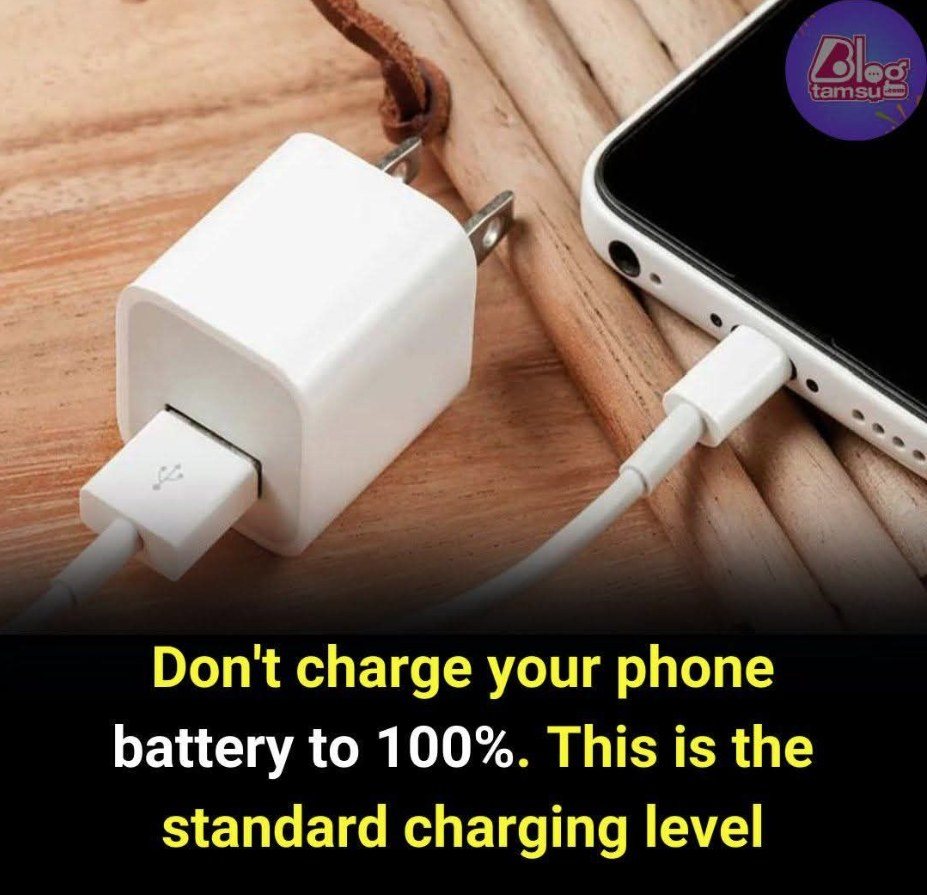In today’s digital age, smartphones have become an essential part of our daily lives. Whether for communication, work, entertainment, or navigation, we rely heavily on our mobile devices. However, one of the most common mistakes people make when charging their phones is always charging the battery to 100%. While this may seem like the best way to ensure a long-lasting charge, the reality is quite the opposite. Overcharging your phone battery can reduce its lifespan, affect performance, and even pose safety risks. Understanding how lithium-ion batteries work and following best charging practices can significantly enhance your device’s longevity. Here’s why you should avoid charging your phone to 100% and what you should do instead.

How Lithium-Ion Batteries Work
Most modern smartphones use lithium-ion (Li-ion) batteries, which store and release energy through a chemical reaction. These batteries have a limited number of charge cycles, meaning that every time you charge and discharge them, they degrade slightly. A full charge cycle is counted when a battery goes from 0% to 100%, but partial charges also contribute to wear and tear. Unlike older nickel-based batteries, lithium-ion batteries do not have a “memory effect,” meaning they do not need to be fully charged or discharged to maintain performance.
The Science Behind Battery Degradation
Over time, charging your battery to 100% can accelerate its degradation due to the increased stress on the battery cells. Here are the key reasons why:
- Voltage Stress: Lithium-ion batteries operate best within a voltage range of 3.7V to 4.2V per cell. Charging your phone to 100% increases the voltage to the maximum limit, which accelerates wear and tear on the battery’s internal components.
- Excessive Heat: Charging to 100% often generates excessive heat, which can damage the battery over time. Heat is one of the biggest enemies of lithium-ion batteries, causing them to age faster and lose capacity.
- Increased Charge Cycles: When you constantly charge your battery to 100% and drain it completely, you use up full charge cycles more quickly. This reduces the overall lifespan of the battery, leading to the need for more frequent replacements.
What Happens When You Charge to 100%?
- Faster Battery Wear: The higher the charge level, the more strain is placed on the battery, leading to a gradual decrease in capacity.
- Overheating Risks: Leaving your phone plugged in after it reaches 100% can cause overheating, which can damage the internal components and reduce efficiency.
- Reduced Battery Life: A battery that is constantly charged to its maximum limit will lose its ability to hold a charge faster than one that is maintained at an optimal level.
Ideal Charging Practices for a Longer Battery Life
To extend the lifespan of your smartphone battery and maintain optimal performance, follow these best charging practices:
- Keep Your Battery Between 20% and 80%
- Charging within this range reduces stress on the battery and helps it last longer. Try unplugging your phone once it reaches 80% instead of letting it charge to 100%.
- Avoid Overnight Charging
- Leaving your phone plugged in overnight can lead to trickle charging, which keeps the battery at full capacity for extended periods. This increases heat generation and stress on the battery.
- Use Slow Charging When Possible
- While fast charging is convenient, it generates more heat, which can speed up battery degradation. Using a regular charger instead of a fast charger can be better for long-term battery health.
- Unplug Once Fully Charged
- If you must charge to 100%, make sure to unplug the device as soon as it reaches full charge to prevent overheating and stress.
- Use Battery Saver Mode
- Many smartphones have built-in battery optimization features that limit background activity and extend battery life. Enable these features when necessary.
- Store Your Phone at the Right Temperature
- Avoid exposing your phone to extreme temperatures, as excessive heat or cold can affect battery performance. The ideal temperature range for lithium-ion batteries is between 15°C and 25°C (59°F and 77°F).
Common Myths About Charging Your Phone
- Myth: Charging to 100% Improves Battery Life
- Reality: Keeping your phone between 20% and 80% extends battery longevity.
- Myth: You Must Fully Drain the Battery Before Charging
- Reality: Lithium-ion batteries perform best with partial charges, not full discharges.
- Myth: Using Your Phone While Charging Damages the Battery
- Reality: While heat generation is a concern, using your phone while charging does not significantly harm the battery if done in moderation.
How Manufacturers Are Addressing Battery Health
To help consumers maximize battery lifespan, many smartphone manufacturers have introduced adaptive charging technologies. Features like Apple’s Optimized Battery Charging and Android’s Adaptive Battery help reduce charge cycles by learning your usage patterns and delaying full charging until necessary. These features help minimize battery stress and improve long-term performance.
Final Thoughts
Charging your phone battery to 100% might seem like a practical habit, but in reality, it shortens battery life and affects performance over time. By understanding how lithium-ion batteries work and following optimal charging practices, you can extend your phone’s lifespan and reduce the need for battery replacements. Keeping your phone’s battery between 20% and 80%, avoiding excessive heat, and using smart charging features can make a significant difference in battery health. Next time you plug in your phone, remember that less can be more when it comes to charging your device.
